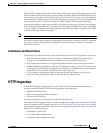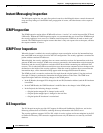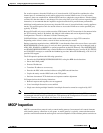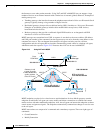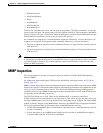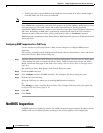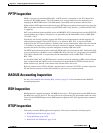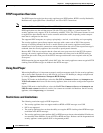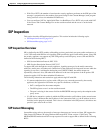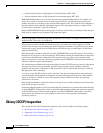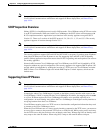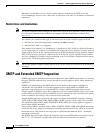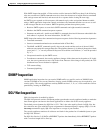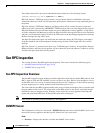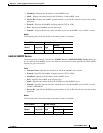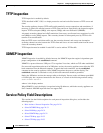
24-21
Cisco ASDM User Guide
OL-16647-01
Chapter 24 Configuring Application Layer Protocol Inspection
SIP Inspection
• With Cisco IP/TV, the number of translates the security appliance performs on the SDP part of the
message is proportional to the number of program listings in the Content Manager (each program
listing can have at least six embedded IP addresses).
• You can configure NAT for Apple QuickTime 4 or RealPlayer. Cisco IP/TV only works with NAT
if the Viewer and Content Manager are on the outside network and the server is on the inside
network.
SIP Inspection
This section describes SIP application inspection. This section includes the following topics:
• SIP Inspection Overview, page 24-21
• SIP Instant Messaging, page 24-21
SIP Inspection Overview
SIP, as defined by the IETF, enables call handling sessions, particularly two-party audio conferences, or
“calls.” SIP works with SDP for call signalling. SDP specifies the ports for the media stream. Using SIP,
the security appliance can support any SIP VoIP gateways and VoIP proxy servers. SIP and SDP are
defined in the following RFCs:
• SIP: Session Initiation Protocol, RFC 2543
• SDP: Session Description Protocol, RFC 2327
To support SIP calls through the security appliance, signaling messages for the media connection
addresses, media ports, and embryonic connections for the media must be inspected, because while the
signaling is sent over a well-known destination port (UDP/TCP 5060), the media streams are
dynamically allocated. Also, SIP embeds IP addresses in the user-data portion of the IP packet. SIP
inspection applies NAT for these embedded IP addresses.
The following limitations and restrictions apply when using PAT with SIP:
• If a remote endpoint tries to register with a SIP proxy on a network protected by the security
appliance, the registration fails under very specific conditions, as follows:
–
PAT is configured for the remote endpoint.
–
The SIP registrar server is on the outside network.
–
The port is missing in the contact field in the REGISTER message sent by the endpoint to the
proxy server.
• If a SIP device transmits a packet in which the SDP portion has an IP address in the owner/creator
field (o=) that is different than the IP address in the connection field (c=), the IP address in the o=
field may not be properly translated. This is due to a limitation in the SIP protocol, which does not
provide a port value in the o= field.
SIP Instant Messaging
Instant Messaging refers to the transfer of messages between users in near real-time. SIP supports the
Chat feature on Windows XP using Windows Messenger RTC Client version 4.7.0105 only. The
MESSAGE/INFO methods and 202 Accept response are used to support IM as defined in the following
RFCs:



